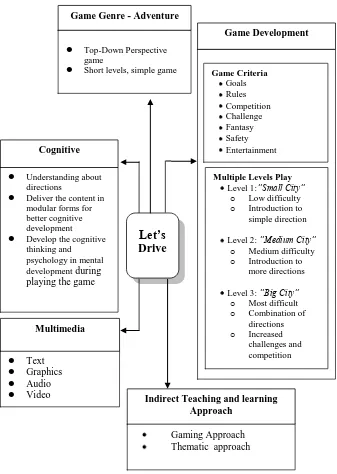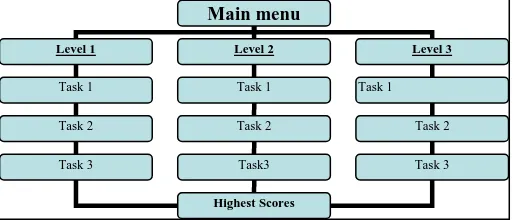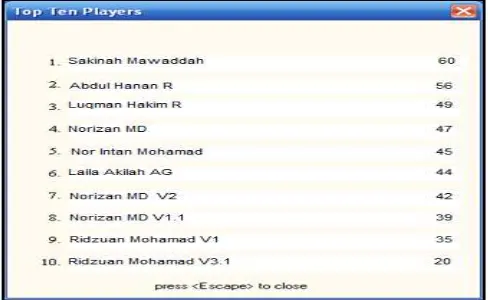Game Development Model for Teaching Direction to School children
Marina Ismail, Norizan Mat Diah, Suzana Ahmad & Mohd Amry Bin Ariffin Fakulti Sains Komputer dan Matematik
Universiti Teknologi MARA (UiTM) 40450 Shah Alam, Selangor Darul Ehsan
marina@tmsk.uitm.edu.my, norizan@tmsk.uitm.edu.my, suzana@tmsk.uitm.edu.my
Proceeding-3rd International Malaysian Educational Technology, IMETC 2009
Abstract
Game education is still in its infancy even though many researchers are now looking into this area. A good educational game must fulfil all the game and learning requirements. This paper discusses about the development of an educational game called Let’s Drive. Let’s Drive is developed to assist children in learning direction in English Language. Let’s Drive is developed according to the Malaysian curriculum for primary schools but can be extended to anybody who wishes to learn direction in English as second language. The development combines the game design methodology and instructional design approach. The game is designed for children at the age of 7 – 9 years old. It is an interactive game which enables children to learn while playing the game. The game has been developed using freeware development tools and proven to be a competitive game just like the games built by professionals. A usability test has been conducted to test the levels of user’s satisfaction towards the product. The study showed that children like to play the game and eventually learn about direction unconsciously. An easy-to-develop game design allows the game to be easily upgraded with more challenging features and multi platform capability. This educational gaming approach can be a promising pedagogy to the learning field.
Keywords: children, educational game, pedagogy
1.0 Introduction
For most kids, gaming is now becoming one of their hobbies. Each month parents spent hundreds of Ringgit buying their child new and latest games available in the market such as games for Playstations, Nintendo, Microsoft Xbox and also computer games. Kids nowadays pay more attention to gadgets, gizmos and games rather than reading children‟s story book or other educational books.
2.0 Education Game for Kids
The positive impact of gaming was first recognized some 3,000 years ago by military organizations and current forms of war-gaming were introduced into Europe in the nineteenth century. Military organizations were also the first to recognize the value of video games in training, although this has only been within the past five or six years. Many should have been struck by the concern military leader‟s show for their 18-20 year old recruits; they are clearly determined to look after these young people to ensure they have all the necessary skills to do the job as safely as possible and video games can be of great value in this (Beck 2005). This technique gives a new idea for people to discover gaming in education. Many would wonder why gaming is useful in education but not many would wonder how to use game in education. This will depend to software or game developer to set a purpose and target in their development and different developer always has a different set of ideology or ways in development. Their target market also will determine how big is their development will be.
Recently, many designers and researchers have become interested in how video games can serve as forms of cultural expression beyond entertainment alone. As part of this series of discoveries, more and more evidence seems to suggest that video games are helping people become well-educated, especially through contextual experimentation with complex systems. But, we have paid little attention to video games role in the broader disparity between the well-schooled and the well-educated. If we want to get serious about the future of educational video games, then we need to recognize and promote video games role in the broader overhaul of our current educational situation (Bogost 2005).
3.0 Educational Game Design for Let’s Drive
The design for Let‟s Drive involves five major elements which are cognitive approach, game genre, multimedia elements, indirect teaching and learning approach and game development. Collaboration between these five elements can be seen to Figure 1 below:
3.1 Cognitive
Figure 1: Conceptual model for Develop educational computer games (Let‟s Drive)
Summarizing strategy is making mental, oral or written summary of information gained at certain points in learning process. To adapt summarizing strategy, Let‟s Drive had prepared an instruction of directions for every phase of game. Each instruction is simple and written clearly. Let‟s Drive also adapt deduction or induction strategy where in this game the player will have to follow some rules, if player is able to follow the rules, extra marks will be given whereas, marks will be deducted when player is unable to follow the rules. For imagery strategy, Let‟s Drive have stimulate mental picture for players from information and graphics given. Mental strategy is to replay a word, phrase or piece of information. For this strategy, Let‟s Drive includes voice and text as a form of instruction to lead the player to play correctly. This voice will appear concurrently as the player play the game and is available throughout the game. Making inference strategy is by using context clues to guess meaning and predict
upcoming information. Let‟s drive uses symbols that act as clues to the player so that they can guess some meaning and predict upcoming information.
A psychiatrist, Gestalt, believes that in each learning process, students will create cognitive structure in their memory (Norizan, 2003). Every time a learning process occurs, a student will structure all his or her learning experience and saved all the experiences in his or her memory. When problems occur and need to be solved, the students will retrieve significance experience in order to help them to solve problems they are facing. For an example, this game requires students to solve a few problems from each obstacle that have been created for them. Each problem was design to test students‟ understanding on their direction skills. For better understanding, this project has engaged the modular design to deliver the content in stages, where each stage delivers a more difficult content and an increased challenge.
This project had adopted the cognitive approach in the design and development of the prototype (Let‟s drive).
3.2 Indirect Teaching and Learning Approach
Let‟s Drive provides a platform for an effective indirect teaching and learning environment. Players will enjoy the game and at the same time the concepts of direction and educational values will be adhered in them. Learning process that the learners had gone through was not realized by the players. Each player just concentrates on getting the highest score without realizing that the new knowledge, that is the direction, has been accumulated in them cognitively. This platform will create tense free environment, therefore it allows learners to enjoy themselves without realizing that they are learning something.
3.3 Game Genre: Adventure
Adventure games, strategy games and all forms of puzzle games are among good examples of games genre that might involve cognitive elements. In most of the adventure game, players are given brief visual or/and verbal instructions on the very basic rules of the game. Arming with this basic knowledge, the players venture into the world of fantasy and learn more about it. When they encounter new things, they learn to adapt it with their existing schema by trial and error or mental reflection. The game gives hints appropriately to help elaborating new information so that it can be connected to the knowledge network easily. In some action games, players know only the basic control of the game and learn by making mistakes and exploring directly in the game world. The top-down approach is effective in computer games, as players begin with a complex and complete task, rather than small parts of the task (Ang & Rao, 2003).
A study that has been conducted on the different type of game genre, showed that adventure game is the most suitable genre for Let‟s Drive Game because the game needs to focus on exploration and also involve item gathering, avoid obstacles and scoring board. In this game development, top-down perspective is employed as it is suitable with the capability of the game engine in making two dimensional (2D) games (GameMaker, 2008). Top-down perspective also sometimes referred to as bird's-eye view, overhead view or helicopter view. The view is a camera angle view used in computer and video games that shows the player and the area around them from above.
3.4 Multimedia
order to develop interesting educational game, multimedia elements such as text, graphic, audio and video should be added. Let‟s Drive embedded audio in each level to increase the players‟ excitement and also understanding. The usage of text element in Let‟s Drive has become a major structure as it is the main medium to interact with the players (through written text). Fun, interesting looking colour 2D graphics has been used throughout Let‟s Drive. Combination of these multimedia elements had brought out the flavours of this game and had attracted players to keep on playing the game.
3.5 Game Development
The development for Let‟s Drive Game adhere to the principles of gaming which incorporated the basic gaming criteria that are goals, rules, competition, challenge, fantasy, safety and entertainment. To consolidate with the modular presentation of knowledge for maximum cognitive development, multiple levels game play has been employed. The multiple levels serve as a twofold function that are as modular content delivery as well as increased challenge of game play.
The content of the Let‟s Drive game consist of directions such as turn left, turn right, go straight and many more as stated in the curriculum. The game design is divided into three levels; with each level has different levels of difficulties. The names of the levels are “Small City”, “Medium City” and the last level is the “Big City”. The names are created as such in order to create a fantasy in the mind of the children while playing the game. Every level consists of three tasks and the structure of this game will be illustrated using the menu hierarchy (Figure 2).
Figure 2: The hierarchy chart from the Let‟s Drive game
For each level, the player/ learner is required follow the instructions in the text that appears at the bottom of the game screen to enable the player/learner to proceed to the next level. It will also display a small screen area to indicate whether the user has taken the correct or the wrong turn in the game. The victory flag shows the final destination that the user must reach. In level 1 (Figure 3), obstacles and the road turn are few. In the game, player/learner needs to follow the direction given while at the same time try to avoid colliding with the obstacles. Obstacles in games are challenges which make the game an interesting piece to play.
Figure 3 : Screen shots for the first level of Let‟s Drive
In level 2 (Figure 4), obstacles and road directions become more difficult with increased number of road turns (directions) and obstacles. More directions are being instructed for the player/learner to be complete within the same amount of time as in Level 1.
Figure 4: Screen shots for the second level of Let‟s Drive
Figure 5: Screen shots for the third level of Let‟s Drive
The highest scores window will be displayed when the game is completed either by successfully completing the game or when the player has finished using all the „life‟ given to them in the game (Figure 6). User needed to write their name or nickname in the scoring window if he or she gets top ten highest score. This feature enhance students motivation level as they tracked their progress (Marina, 2009).
Figure 6: Screen shots for Top ten highest scores
4.0 Evaluation
satisfaction after completing the game. The questions and answers are structured using a 5 point Likert scale with 1 for strongly agree and 5 for strongly disagree. All questions was designed to get the input from the children on how they feel about the game, do they like it and was it to easy to play or not.
The effectiveness and efficiency are measured using a simple usability metrics introduced by Jacob Nielsen (Nielsen 2001). The metrics analyzes user's success rate. Based on the analysis of the success rate, the level of effectiveness is 71% and the level of efficiency is 56%. The analysis on post questionnaire of satisfaction level is 82%. By averaging the rate of effectiveness, efficiency and satisfaction, the usability level is approximately 70%. However, detail explanation about the usability test is not discussed in this paper.
5.0 Conclusion
„Let‟s Drive‟ was developed as an alternative to learning direction in English Language to school children. Gaming approach was chosen as an approach to teach about direction as gaming has proven to be a very attractive way to get children to hook on a material for a longer period of time. Educational game has also proven to promote indirect learning where learners play without realizing that they actually learning. Crawford (2003) stated that every human being has an instinct to learn by playing. The top-down perspective of „Let‟s Drive‟ also provides the visualization of how the move from one place to another happens when the player follow certain directions. This feature extends the capability of a text book and allows learners to understand better through visual learning. A usability test conducted showed that users are satisfied with the approach use in teaching about directions. Educational game has proven to be an interesting and attractive method for learning.
References
Ang, S. and Rao, R. K. 2003. Theories of Learning: A Computer Games perspective. IEEE Fifth International Symposium on Multimedia Software Engineering, pp. 239-245.
Bevan, N., Kirawoski, J. & Maissel, J. 1991. What is Usability? Proceedings of t he 4th International Conference on HCI, Stuggart, September. http://www.nigelbevan.com /papers/ whatis92.pdf [3 October 2009].
Bogost, I. 2005. Videogames and the future of education. Campus-Wide Information Systems. 13(2), pp. 119-125.
Chamot, U. and O'Malley, J.M. 1994. The CALLA handbook: Implementing the cognitive academic language learning approach. Longman. New York, NY
Crawford, C. 2003. The Art of Interactive Design. No Starch Press. San Francisco.
Game maker http://www.mindtools.tased.edu.au/gamemaker [3 July 2008].
Hermann, A. 2008. Multimedia Elements and Emotional Processes. http://www.usq.edu.au/electpub/ejist/docs/Vol7_no2/FullPapers/MMelements.htm
[4 November 2008].
Marina Ismail. 2009. Perisian Kursus Multimedia (BACA) untuk pembelajaran Bahasa Melayu peringkat pra sekolah menggunakan pendekatan Vygotsky. PhD Thesis. Universiti Kebangsaan Malaysia.
Md Dahari, M.K. 2008. Usability Testing With Children for Educational Game Using Observation Method. Master Thesis, Mara University of Technology.
Nielsen, J. 2001. Usability Metrics. Jakob Nielsen‟s AlertBox.
http://www.useit.com/alertbox/20010121.html [2 October 2009].


